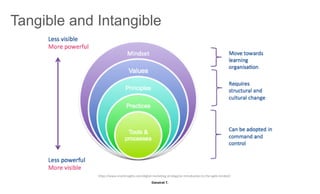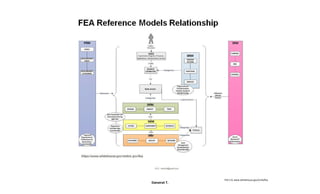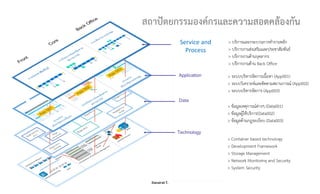Ad
Agile Enterprise Architecture - Danairat
- 1. Danairat T. อ.ดนัยรัฐ ธนบดีธรรมจารี Line ID: danairat FB: www.facebook.com/tdanairat Agile Enterprise Architecture Digital Initiatives Digital Platform Business Services & Business Objectives N e w S e r v i c e s O p t i m i z e d S e r v i c e s R e t i r e d S e r v i c e s C E O C F O C O O C M O B i g D a t a D i g i t a l S e c u r i t y “Innovation” “Efficiency” “Sustainability” Cloud Data Monetization New Customers, Channels IoT, Smart Devices Business Process Optimization/Outsou rcing Smart Workforce Enterprise Metamorphosis Digital Organization Business Process as a Service More Control More Flexible Vision, Mission Statements The Digital Transformation Series • Why we need Enterprise Architecture? • What is Enterprise Architecture and The Agile Enterprise Architecture? • How to build Enterprise Architecture
- 2. Danairat T. ทําไมเราจึงต้องการสถาปัตยกรรมองค์กร Why do we need Enterprise Architecture (EA)?
- 3. Danairat T. IT Silos Database Core App Database CRM App Database Other Apps Database HR App Database Finance App IT Silos make inefficient to scale the business โปรดขออนุญาตก่อนนําไปใช้ต่อ
- 4. Danairat T. Business Silos Real example of Spaghetti process describing the diagnosis and treatment of 2,765 patients in a Dutch hospital. http://www.processmining.org/_media/processminingbook/process_mining_chapter_12_analyzing_spaghetti_processes.pdf
- 5. Danairat T. Without Blueprint vs. with Blueprint Inefficient Complex and Delay Response Productive Business and IT Alignment Cloud, IOT, Big Data, AI, RPA, Blockchain, FaaS, BaaS, IaC VS. FBT PAY G NTS TRDS Client Customs RRE IPS Integrated A/C Refunds RBA Def Payments Excise CR PKI ECI ADD AWA ELS Client Staff Remote Staff TAX AGENTS GCI Call Centres WOC CCD TASS Staff Phone Compliance Staff BOA Ref material Bus. Intel NTS A/c BEP CDCC CWMS BANK DDDR 1 Data……. Penalty Business IVR 1 FBT PAY G NTS TRDS Client Customs RRE IPS Integrated A/C Refunds RBA Def Payments Excise CR PKI ECI ADD AWA ELS Client Staff Remote Staff TAX AGENTS GCI Call Centres WOC CCD TASS Staff Phone Compliance Staff BOA Ref material Bus. Intel NTS A/c BEP CDCC CWMS BANK DDDR 1 Data……. Penalty Business IVR 1 • เป้าหมาย (Goals, Directions) • คนและโครงสร้างทีมงาน (Roles & Organization) • นโยบายและขั+นตอนการทํางาน (Policies, Processes) • Web, Mobile Apps • Analytics, AI Apps • Application Data • Integration Data • Historical Data • IOT, Cloud Platform • Security and Monitoring • H/W, Network Insight and Monitoring Innovation, Citizen Relationship Management Regulatory Compliance Corporate Admin. Core Services System Monitoring and Management Security/ Auditing and Identity Management Enterprise Infrastructure Enterprise Information Management โปรดขออนุญาตก่อนนําไปใช้ต่อ
- 6. Danairat T. สถาปัตยกรรมองค์กรคืออะไร และมีประโยชน์อย่างไรบ้าง What is an EA and key benefits?
- 7. Danairat T. สถาปัตยกรรมองค์กร (Enterprise Architecture) คืออะไร สถาปัตยกรรมองค์กรคือการออกแบบความสัมพันธ์ขององค์ประกอบ และหน่วยความสามารถ ต่าง ๆ ในองค์กรเพื'อให้แต่ละองค์ประกอบในองค์กรทํางานอย่างสอดคล้องร่วมกันเพื'อขับเคลื'อน กลยุทธ์ขององค์กรนําสู่การปฏิบัติอย่างเป็นรูปธรรม https://hoba.tech/what-is-the-business-architecture-challenge/
- 8. Danairat T. Types of Architectures Architecture Description Enterprise Architecture Creating enterprise blueprint with facilitate all architects and key business executives to build organizational transitioning roadmap. Business Architecture Creating business operating model, business services, organization and business process/policy. Solution Architecture Creating an information system with its integration. Application Architecture Creating an application touch points with screen flows and creating report results. Data Architecture Creating data model both structured and unstructured data and governance framework. Technology and Infrastructure Architecture Creating digital infrastructure and smart office including network, office automation, wireless, storage, cloud, big data and security infrastructure.
- 9. Danairat T. Enterprise Architecture Framework History TOGAF9.1 2011 TOGAF9.2 2018 TOGAF9 2009 https://www.leanix.net/en/blog/the-pain-of-using-a-non-cloudbased-eam-tool
- 10. Danairat T. Zachman Framework • Zachman developed a structure or framework for defining and capturing an architecture • This framework provides for 6 perspectives or “windows” from which to view the enterprise.
- 11. Danairat T. TOGAF Architecture Development Method The ADM method consists of eight main phases. As preliminary work, the enterprise architecture framework and architecture principles are fixed for the effort. In the following, a short description of the phases. A. Architecture vision is the analysis phase of EA project. The project is organized; the scope and domain requirements and constraints are stated. Business scenarios can be used for this. B. Business architecture phase, the current baseline architecture is stated, target architecture is designed and a gap analysis between the two takes place. C. Information systems architecture consists of the parts Data and Applications. For Data architecture, the types and sources of data needed in the enterprise are defined and a data model is created. A gap analysis is conducted and data model is compared with the business architecture. As to the applications, the applications needed to meet the specified business requirements and data model are turned into an applications architecture and are checked back with the business architecture. D. Technology architecture, the previous phases deliver inputs. In this phase, a baseline architecture is stated, and the target technology architecture is designed. E. Opportunities and solutions is the evaluation phase, where the solutions are selected. F. Migration planning is the point for checking dependencies in the environment and preparing for implementation of the target architecture. G. Implementation and Governance is about the administration of implementation and deployment phase of the development project. H. Architecture change management is the maintenance phase. A new baseline is created and changes in business environment are monitored as well as new technology opportunities. www.opengroup.org https://thunk.technology/blog/togaf-adm-big-bang-theory
- 13. Danairat T. Tangible and Intangible https://www.smartinsights.com/digital-marketing-strategy/an-introduction-to-the-agile-mindset/
- 15. Danairat T. From traditional EA to Agile EA
- 16. Danairat T. 5 Principles of An Enterprise Architect No. Name Statement 1 Business Innovation and Strategic Alignment EA to facilitate innovation and provide alignment to the business. 2 Technology Independence Applications are independent of specific technology choices and therefore can operate on a variety of technology platforms. 3 Data is an Asset Data is an asset that has value to the enterprise and is managed accordingly. 4 Business Continuity and Responsive Change Enterprise operations are maintained despite system interruptions. Changes to the enterprise information environment are implemented in a timely manner. 5 Compliance with Law Enterprise information management processes comply with all relevant laws, policies, and regulations.
- 17. Danairat T. Key Benefits from Enterprise Architecture Benefit Description Innovation Enterprise can be able to create new innovation by using EA centralized repository Productivity Faster to build new service from existing IT inventory Cost Saving Cost saving with reusable process, application, data and infrastructure EA creates a foundation for digital business execution including cloud, big data, social, mobile, and smart workforce Reduce Risk EA simplify IT complexity and governs the change impact analysis for new services deployment
- 18. Danairat T. การสร้างสถาปัตยกรรมองค์กร Building your Enterprise Architecture
- 19. Danairat T. Building Enterprise Architecture The Guideline 1. Identify EA goals and scope 2. Identify EA team (Strategy, Planning, IT, COO, CFO) 3. Create current architecture 4. Develop targeted architecture 5. Develop transitioning roadmap with governance 6. Replicate to new scope
- 20. Danairat T. Enterprise Blueprint Prepared by:_______________________________ Version: ____ Date/Time: ________________ Single Command Center Breakdown Performance Ranking, Benchmarking Insight Management Customer Relationship Management Risk Management HRM, HRD Accounting Procurement Finance Building, Safety Customer Data Service Data Transaction Data Organization Data Policy Data IT Services Innovation Management Products/Services Products/Services Products/Services Products/Services Products/Services Products/Services Infrastructure Technology (Cloud, Multi-tenancy , IoT sensors) Decision Technology (AI, ML, System Metadata Management) Data Technology (Big Data, NoSQL, Graph DB) Process Technology (BPMN, Event Driven, RPA, APT Gateway) User Touchpoint Technology (Frontend Dev., Mixed Reality) Data Sec. Access Control, and Process Sec. Service Level Mgmt. Sentimental Mgmt. System and Network Sec Cloud Management Data Technology (Technical Frameworks and Infrastructures) Core Services Monitoring Technology Management (เทคโนโลยีติดตามสถานะ) Security Technology Management (เทคโนโลยีความปลอดภัย) Performance Management (บริการรายงาน ผลการดําเนินงาน) Experience Management (บริการงานนวัตกรรม ส่งเสริมประชาสัมพันธ์) Corporate Admin., Back Office (บริการงานสนับสนุน) Laws, Compliance and Audit (บริการงานคุณภาพ และ กฎระเบียบ) Audits and Controls Laws ( PDPA, ETC. ) Sandbox Management โปรดขออนุญาตก่อนนําไปใช้ต่อ
- 21. Danairat T. Digital Enterprise Blueprint Performance Model Innovation, CRM รายงานประจําปี CRM Survey ความพึงพอใจ Online Research งาน CSR ระบบประเมินผลTRIS News Clipping รับเรืKองร้องเรียน Regulatory Compliance Corporate Administration HRM/HRIS MIS Supply&Asset eGP E-Contact CATC Core Business Access Channels Web Mobile/IOT Voice Over IP Branch i-Train System ระบบบริหารการศึกษา E-Register ข้อมูลนักศึกษา ข้อมูลอาจารย์ ข้อมูลประเมินการเรียน/การสอน ข้อมูลการสอบ ข้อมูลหลักสูตร Enterprise Data and Information Management E-Resource Instructor System System Monitoring and Management Security/Auditing and Identity Management Networking and Cloud Infrastructure Digital Asset, Rule and Configuration Repositories Data Management and Data Integration Platform Business Process Platform Standard User Interfaces, Standard IOT Touchpoints Identity Sec. Data Sec. Process Sec. Monitoring Autonomous Data Center Service Level Management Network Sec Cloud Management Digital Platform E-Sarapan Learning Management System Inventory Stock Fingerprint Scan DocumentProduction(โรงพิมพ์) Online Printing E-Budget E-Classroom(ป.ตรี) MCTA SARC E-Admission Examination System iWork Activiz House Keeping Finance Account APPLY App(ระยะสั]น) ข้อมูลงบประมาณ ข้อมูลหน่วยงาน ข้อมูลบุคลากร ข้อมูลจัดซื]อจัดจ้าง ข้อมูลวัสดุ/ครุภัณฑ์ ข้อมูลเบิกจ่าย/การเงิน ข้อมูล Traveling Schedule Theoretical Instruction Practical Instruction ข้อมูลการฝึ ก ข้อมูลข่าวอากาศ E-Library Student Intelligent Center AMSS ระบบส่งข่าวอากาศอัตโนมัติ Student Pilot Alert ระบบซ่อมบํารุงอากาศยาน An Intelligent Teaching System E-Tools Tool Control System Smart Class Room Smart Central Laboratory & Store Student on Line Smart Student ID Card Smart Corporative Smart Advisor & Study Planning Request เปิดคอร์สฝึ กอบรม Service Upgrade ระบบบวิทยานิพนธ์/สอบ ประกาศกระทรวง พระราชกฤษฎีกา กฎกระทรวง Policy Internal Audit พระราชบัญญัติ ข้อบังคับ/ระเบียบ มาตรฐานสากล KM แผนวิสาหกิจ แผนบริหารความเสียง แผนควบคุมภายใน IC Regulation E-Calendar E-News Generating ระบบ Alumni (ข้อมูลศิษย์เก่า) GFMIS จองห้องออนไลน์ E-Document ระบบโสตท ัศนูปกรณ์ A lfresco ระบบจ ัดการเอกสาร Training Management iCo-Operative Society AIP Th/Jeppesen program ข้อมูลกรมการปกครอง ข้อมูลคุณวุฒิการศึกษา ข้อมูลสิทธิบัตร ข้อมูลวิจัย/วิทยานิพนธ์ ข้อมูลทุนวิจัย ข้อมูล Jeppesen ข้อมูลห้องสมุด การประกันคุณภาพ Core Business System Finance & Accounting Risk Governance Research, Business Development, CRM HR, Procurement, Smart Building Enterprise Performance Management Enterprise Data Management Enterprise Data Government Digital Security Digital Monitoring Digital Platform (Network, Cloud Infrastructure, Integration System, and Standard User Interface) โปรดขออนุญาตก่อนนําไปใช้ต่อ
- 22. Danairat T. Digital Tourism Platform Performance Management Innovation and Business Dev Performance Reports Breakdown KPIs Govt. Ranking Digital Marketing Citizen Relationship Social Listening Security Management Corporate Administration Risk Management Laws HR, HCM Accounting Procurement Audits and Controls Finance Env. Safety กฎกระทรวง Core Digital Tourism Services Festival Mgmt Tourist User Experience Service Integration Plan Branch Service Mgmt Tourists Data Service Data Transaction Data Policy Data Organization Data Data and Information Management Cases Mgmt IT Service Monitoring Management Security/Privacy Management Cloud Infrastructure Decision Centric Platform (ML, Deep Learning) Data Lake, Big Data Platform Business Process and Approval Workflow Platform Web Scale UI, Mobile, IOT Access Identity Sec. Data Sec. Process Sec. Monitoring Sentimental Service Level Management Network Sec Cloud Management Digital Tourism Technology Platform IoT and Image Recognition สํานักงานปลัดการท่องเทียว นักท่องเทียว การเงินการคลัง, บุคคลากร บัญชี B2B ผู้ประกอบการท้องถิน การท่องเทียว ปทท. Mobile dashboards, Notifications and Tasks tracking system Book Travel Evaluate Intelligent Center Place Mgmt Activities Mgmt Shop Mgmt Eat Health PPP Mgmt Document Mgmt B2C คณะทํางานประชารัฐ Nong Tak-Thai โปรดขออนุญาตก่อนนําไปใช้ต่อ
- 23. Danairat T. FEA 2.0, www.whitehouse.gov/omb/fea
- 24. Danairat T. FEA 2.0, www.whitehouse.gov/omb/fea
- 25. Danairat T. The Enterprise Reference Model Mapping with Federal Enterprise Architecture Framework
- 26. Danairat T. Open Standard EA Toolset
- 27. Danairat T. ข้อมูลเหตุการณ์ต่างๆ (Data001) ข้อมูลผู้ใช้บริการ(Data002) ข้อมูลด้านกฎระเบียบ (Data003) Container based technology Development Framework Storage Management Network Monitoring and Security System Security ระบบบริหารจัดการเนื้อหา (App001) ระบบวิเคราะห์และติดตามสถานการณ์ (App002) ระบบบริหารจัดการ (App003) บริการและกระบวนการทํางานหลัก บริการงานส่งเสริมและประชาสัมพันธ์ บรืการงานด้านบุคลากร บรืการงานด้าน Back Office สถาปัตยกรรมองค์กรและความสอดคล้องกัน Service and Process
- 28. Danairat T. Performance Management Experience Management Laws, Compliance and Audit Operational Excellence Core Services Monitoring Management Security Management Digital Technology Management Common Data New Changed Retired Unchanged From current Enterprise Blueprint to target Enterprise Blueprint สถาปัตยกรรมเป้าหมาย Performance Management Experience Management Laws, Compliance and Audit Operational Excellence Core Services Monitoring Management Security Management Digital Technology Management Common Data สถาปัตยกรรมปัจจุบัน Architectures Transitioning
- 29. Danairat T. Agile Enterprise Architecture Enterprise Blueprint (Organization Skeleton) Strategic Implementation (Organization Organs) OKRs DDD Data and Stakeholders Skills, Culture, Laws AI, Big Data, IOT, etc. Product/Service Owner Microservices, POD Container design spec. Agile Team • Build Agile Culture • Empower Teamwork • Sustainable Governance • Continuous Improvement โปรดขออนุญาตก่อนนําไปใช้ต่อ
- 30. Danairat T. Business Service Overview “Business service is a general term that describes work that supports a business.” https://searchcio.techtarget.com/definition/business-services Business service can be the service for external customer such as sales service, marketing service and internal customer such as employee service, procurement service, accounting service Organization needs to identify business services which provided for both external and internal as their organization portfolio or catalog. Business service describes its objective outcomes, service owner, key stakeholder, key process, output, key business supports and key digital supports for continue business service improvement. โปรดขออนุญาตก่อนนําไปใช้ต่อ
- 31. Danairat T. Enterprise Architecture and DevOps Digital Organization Transformation Enterprise Architecture Digital Services (DevOps) • Enterprise Service Portfolios • Capabilities • Enterprise Transitioning Roadmap • AI • Robotics • Big Data • IOT • Cloud • Etc. • Directions • Flagships Operating Model • People Skills and Partnerships • Governance • Digital Service Development • Continue Improvement โปรดขออนุญาตก่อนนําไปใช้ต่อ
- 32. Danairat T. Business Process – Manned and Unmanned at Work Cloud Sync Data Filter Logic Manager RPA Approve ? Save Data 200ms 100ms 10mins – 120mins 100ms โปรดขออนุญาตก่อนนําไปใช้ต่อ
- 34. Danairat T. อ.ดนัยรัฐ ธนบดีธรรมจารี Line ID: danairat FB: https://www.facebook.com/tdanairat Together we can! Thank you.





















![Danairat T.
Digital Enterprise Blueprint
Performance Model Innovation, CRM
รายงานประจําปี CRM
Survey ความพึงพอใจ
Online Research
งาน CSR
ระบบประเมินผลTRIS
News Clipping
รับเรืKองร้องเรียน
Regulatory Compliance
Corporate
Administration
HRM/HRIS
MIS
Supply&Asset
eGP E-Contact
CATC Core Business
Access Channels
Web Mobile/IOT Voice Over IP Branch
i-Train System
ระบบบริหารการศึกษา
E-Register
ข้อมูลนักศึกษา ข้อมูลอาจารย์ ข้อมูลประเมินการเรียน/การสอน ข้อมูลการสอบ ข้อมูลหลักสูตร
Enterprise Data and Information Management
E-Resource
Instructor System
System
Monitoring and
Management
Security/Auditing
and Identity
Management
Networking and Cloud Infrastructure
Digital Asset, Rule and Configuration Repositories
Data Management and Data Integration Platform
Business Process Platform
Standard User Interfaces, Standard IOT Touchpoints
Identity Sec.
Data Sec.
Process Sec.
Monitoring
Autonomous Data Center
Service Level Management
Network Sec
Cloud Management
Digital Platform
E-Sarapan
Learning Management System
Inventory Stock
Fingerprint Scan
DocumentProduction(โรงพิมพ์)
Online Printing
E-Budget
E-Classroom(ป.ตรี)
MCTA
SARC
E-Admission
Examination System
iWork Activiz
House Keeping
Finance
Account
APPLY App(ระยะสั]น)
ข้อมูลงบประมาณ ข้อมูลหน่วยงาน ข้อมูลบุคลากร
ข้อมูลจัดซื]อจัดจ้าง ข้อมูลวัสดุ/ครุภัณฑ์ ข้อมูลเบิกจ่าย/การเงิน ข้อมูล Traveling Schedule Theoretical Instruction Practical Instruction ข้อมูลการฝึ ก ข้อมูลข่าวอากาศ
E-Library
Student Intelligent Center
AMSS
ระบบส่งข่าวอากาศอัตโนมัติ
Student Pilot Alert
ระบบซ่อมบํารุงอากาศยาน
An Intelligent Teaching
System
E-Tools
Tool Control System
Smart Class Room
Smart Central Laboratory &
Store
Student on Line
Smart Student ID Card
Smart Corporative
Smart Advisor &
Study Planning
Request
เปิดคอร์สฝึ กอบรม
Service Upgrade
ระบบบวิทยานิพนธ์/สอบ
ประกาศกระทรวง
พระราชกฤษฎีกา
กฎกระทรวง
Policy
Internal Audit
พระราชบัญญัติ
ข้อบังคับ/ระเบียบ
มาตรฐานสากล
KM
แผนวิสาหกิจ
แผนบริหารความเสียง
แผนควบคุมภายใน IC
Regulation
E-Calendar
E-News Generating
ระบบ Alumni
(ข้อมูลศิษย์เก่า)
GFMIS
จองห้องออนไลน์
E-Document
ระบบโสตท ัศนูปกรณ์
A lfresco
ระบบจ ัดการเอกสาร
Training Management iCo-Operative Society AIP Th/Jeppesen program
ข้อมูลกรมการปกครอง ข้อมูลคุณวุฒิการศึกษา ข้อมูลสิทธิบัตร ข้อมูลวิจัย/วิทยานิพนธ์ ข้อมูลทุนวิจัย ข้อมูล Jeppesen ข้อมูลห้องสมุด
การประกันคุณภาพ
Core Business
System
Finance &
Accounting
Risk Governance
Research,
Business
Development,
CRM
HR,
Procurement,
Smart Building
Enterprise
Performance
Management
Enterprise
Data
Management
Enterprise
Data
Government
Digital Security
Digital
Monitoring
Digital Platform
(Network, Cloud Infrastructure, Integration System, and Standard User Interface)
โปรดขออนุญาตก่อนนําไปใช้ต่อ](https://image.slidesharecdn.com/danairat-agileenterprisearchitecturev2021010-210130002448/85/Agile-Enterprise-Architecture-Danairat-21-320.jpg)
















































































